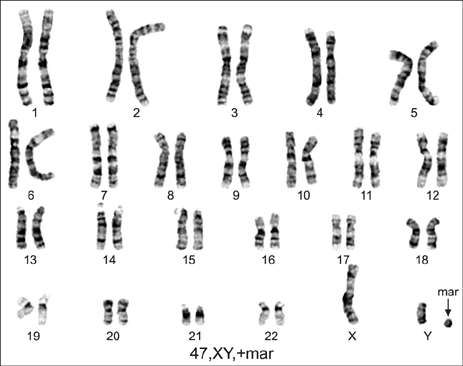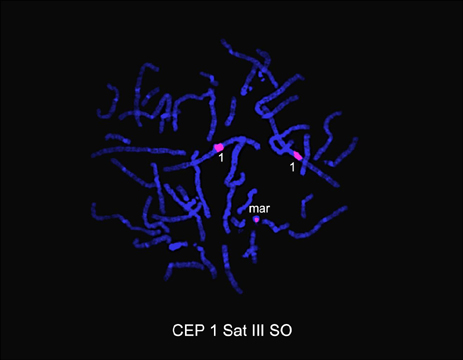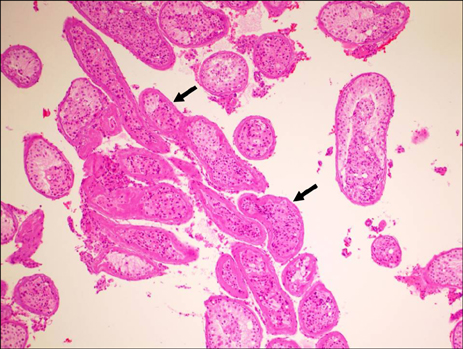World J Mens Health.
2017 Dec;35(3):205-208. 10.5534/wjmh.17015.
Male Infertility Associated with a Supernumerary Marker Chromosome
- Affiliations
-
- 1Department of Urology, CHA Gangnam Medical Center, CHA University, Seoul, Korea. dskim100@chamc.co.kr
- 2Department of Genetics, CHA Gangnam Medical Center, CHA University, Seoul, Korea.
- 3Department of Pathology, CHA Gangnam Medical Center, CHA University, Seoul, Korea.
- 4Fertility Center, CHA Gangnam Medical Center, CHA University, Seoul, Korea.
- 5Department of Urology, Yonsei University, Wonju College of Medicine, Wonju, Korea.
- KMID: 2398570
- DOI: http://doi.org/10.5534/wjmh.17015
Abstract
- A marker chromosome (mar) is a structurally abnormal chromosome in which no part can be identified. The significance of a marker varies, depending on the material contained within the marker. Very few reports have been published of marker chromosomes associated with male infertility. Here, we report the case of an infertile man with a rare variant of a marker chromosome of a mos 47,XY,+mar[25]/46,XY[25] karyotype.
Figure
Reference
-
1. Ferlin A, Raicu F, Gatta V, Zuccarello D, Palka G, Foresta C. Male infertility: role of genetic background. Reprod Biomed Online. 2007; 14:734–745.
Article2. Carrell DT, De Jonge C, Lamb DJ. The genetics of male infertility: a field of study whose time is now. Arch Androl. 2006; 52:269–274.
Article3. O'Flynn O'Brien KL, Varghese AC, Agarwal A. The genetic causes of male factor infertility: a review. Fertil Steril. 2010; 93:1–12.4. Silber SJ, Repping S. Transmission of male infertility to future generations: lessons from the Y chromosome. Hum Reprod Update. 2002; 8:217–229.
Article5. Manvelyan M, Riegel M, Santos M, Fuster C, Pellestor F, Mazaurik ML, et al. Thirty-two new cases with small supernumerary marker chromosomes detected in connection with fertility problems: detailed molecular cytogenetic characterization and review of the literature. Int J Mol Med. 2008; 21:705–714.
Article6. Buckton KE, O'Riordan ML, Ratcliffe S, Slight J, Mitchell M, McBeath S, et al. A G-band study of chromosomes in liveborn infants. Ann Hum Genet. 1980; 43:227–239.
Article7. Koç A, Onur SO, Ergün MA, Perçin EF. Supernumerary marker chromosome 15 in a male with azoospermia and open bite deformity. Asian J Androl. 2009; 11:617–622.
Article8. Carrell DT. Contributions of spermatozoa to embryogenesis: assays to evaluate their genetic and epigenetic fitness. Reprod Biomed Online. 2008; 16:474–484.
Article9. Oates RD. The genetic basis of male reproductive failure. Urol Clin North Am. 2008; 35:257–270. ix
Article10. Brugh VM 3rd, Maduro MR, Lamb DJ. Genetic disorders and infertility. Urol Clin North Am. 2003; 30:143–152.
Article
- Full Text Links
- Actions
-
Cited
- CITED
-
- Close
- Share
- Similar articles
-
- Analysis of Chromosomal Abnormality in Male Infertility
- A Case of Associated with Autosomal Reciprocal Translocation
- Marker Chromosomes in Korean Patients: Incidence, Identification and Diagnostic Approach
- BBilateral Intranasal Supernumerary Teeth
- Partial Tetrasomy of Chromosome 22q11.1 Resulting from a Supernumerary Isodicentric Marker Chromosome in a Boy with Cat-eye Syndrome




